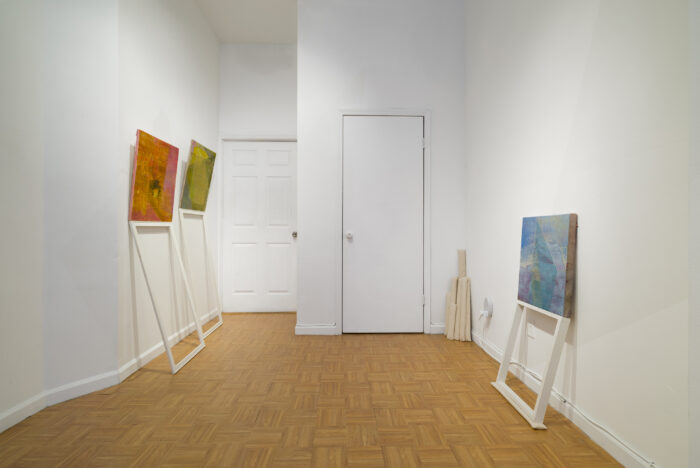
Abstract paintings, human height with hinges articulating the joints of their multi-paneled bodies, lounge nonchalantly in Jan Dickey’s ‘The Generations’ at Bob’s Gallery. Their bottom edges rest on the floor, standing on the same ground as the viewers who move about the room. Each painting is differently dimensioned and idiosyncratically adorned, suggesting different ages and personalities, but all are united through a genetic code of painterly material and form. The two largest, facing each other across the room, seem to be the parents, the smallest painting in the room shyly hiding behind one of them. Two teenagers sulk in the hallway, while two smaller painting-children daydream in different corners. We are invited into their living space to get to know them, and when we do we find signs of their development—seams, cracks, exposed canvas, layers of paint. The installation reminds us that paintings are, in their own way, living beings that develop, age, pass down traditions, and demand attention the way humans do. The viewing experience becomes a conversation.
The following conversation between Jan Dickey and Anna Gregor took place on the occasion of ‘The Generations,’ on view at Bob’s Gallery through August 18th.
—
Anna Gregor: Welcome, everyone. I’m Anna Gregor and I’m going to facilitate this interview. This is a continuation of conversations around painting that Jan and I have been having. The latest installment was published in Whitehot Magazine, in which we discussed contemporary painting topics in relation to a show of mine. Now we’re going to bring those topics into conversation with Jan’s work more explicitly on the occasion of his site-specific installation ‘The Generations’ here at Bob’s Gallery.
There are three topics I want to bring from that past conversation. The first is a trend in painting we’ve noticed: a return to traditional genre paintings––portraits, still lifes, landscapes––depicted so that they seem to be fading from sight. They’re often sepia-toned, washy with a lot of solvent, maybe airbrushed or blurred. They retreat from the gaze.
The second topic I want to bring in is the idea of painting as an inheritance of tradition. People have been painting for over 40,000 years, and here we are, still doing it. In the Western tradition of painting, there was the narrative of painting as imitation that predominated from the Renaissance to the 1860s. And then there was the Greenbergian Modernist narrative of painting as a teleological progression toward pure abstraction. Both of those narratives seem to have failed us. It seems like painting is adrift without a narrative that guides its progression—which is not necessarily a bad thing. But it means that today every painter has to choose how they’re inheriting whatever tradition they decide to inherit.
The final topic I want to bring in is the idea of paintings as animate beings, the process of painting as facilitating their coming into the world. Jan talks about it as a collaboration with the non-human world.
I think this idea of paintings as animate beings is a good place to start. The show we are sitting in right now is called “The Generations” and that suggests a family. The paintings are hinged together, human height. They’re not hanging on the walls like they usually do. They’re slumping or leaning up against the walls. The way they’re situated in space makes them humanoid.
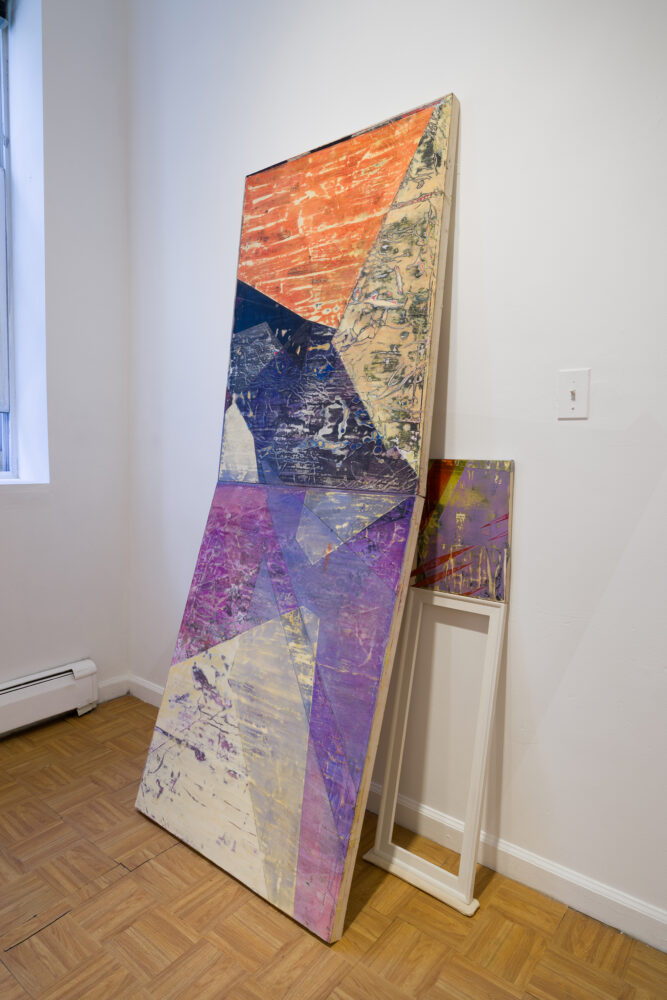
So I want to start by asking you: What was the thought process that led to this exhibition or installation project?
Jan Dickey: Well, I did work last year hinging paintings directly to the wall. So hinges on one side, and you could open it like a door to see the back of the work. That was a way of being able to access both sides of the painting and see it as a physical object in space. So I still had some hinges floating around in my studio, and I think one day I was just trying to make a painting bigger. So it was this one over here, the one that I titled “Coraline Generation,” and I decided to hinge those two panels together to make it larger. Then I noticed when I leaned it against the wall it had a little bit of a bend to it, which, to me, felt sort of like my own body posture, which is not perfectly straight. It’s a little bit like a spinal curve, and there was this languid, casual feeling of the painting slumped against the studio wall. And I was like “It’s almost like a person!”––like the way that a person would slump into their space when they’re relaxed and maybe not at full attention or engaged in something; they’re on break.
So when I got invited to show at Bob’s Gallery I started thinking about how to interact with the fact that Bob’s is an apartment gallery and that these things are going to be living with Bob. I started looking at the painting that was slumped against the wall as an opportunity to build out a family that would exist in Bob’s family room. From there I kept branching out. Trying out different dimensions, and different ways of attaching paintings to each other or to these blank frames that are made from stretcher bars or crossbars in the case of the blue one. And it just grew into this grouping.
Then when it came time to come into Bob’s as an artist in residence, I started laying out the show and thinking about how they were going to have relationships with each other, as family members do. Maybe some family members are closer to others. You’ve got teenagers that are off in the hallway, maybe on their phones or pulling on a vape. You got a little kid that wants to be tucked behind their parent. I wanted the installation of the works as an evolution of that thinking; of the paintings as persons and as a collection of persons that have some sort of familial relationship to one another.
AG: Nice. They’re anthropomorphic and we relate to them as bodies in a way. Especially these two. (Gesturing to “Sunny Generation” and “Saige Generation”) The upper half of them functions as a torso, as opposed to the legs of the frame they are attached to. That suggests a one-to-one relationship between the viewer and the painting, closer to how we usually interact with other people. It’s like a conversation. I’m wondering how you think of the viewing experience––whether the audience is participating in a conversation with the paintings. If a “conversation” is coming to understand another person’s language or how they talk, then what is the language of your paintings?
JD: The reason I wanted to have this talk sitting on the floor was to get on the level with the paintings since the paintings are on the ground. To change the relationship between the viewer and the painted object, which is normally hoisted up to the wall to be at our eye level so we can, like, behold it at our convenience. I think about the reciprocity between the object and the person a lot in my process. I’m constantly trying to bring things into the process that fuck up my authorship, that disrupt my ability to control what’s happening compositionally.
All the paintings in this show were composed using light shapes that came through my studio window and landed on the surfaces. When I found something that was like, “Oh, that’d be a good way to move the composition forward” I would trace it with paint. You’ll see these really thin lines in the paintings, and those are the shapes that the light was making through my studio window at different times of the year. There’s a bit of a record from like last fall up until the summer of the different kinds of shapes that were coming through my studio.
Some people don’t always notice it right away, but there are also shapes on the walls of Bob’s Gallery that I made with primer. I tried to further bring those light shapes into the room and create a movement in the space itself. So compositionally I’m bringing this thing that I can’t fully control into it.
But then I’m also doing that through the way that I layer binders. So… I do everything wrong with, like, in terms of, fat over lean, water-based paint over oil, layering things in ways that destabilize the lamination of the painting. And when these things are in process they’re always cracking and peeling. They’re really unwieldy and out of control. I do a lot of sanding and a lot of pushing different binders into the cracks to hold them together. As I’m destroying the surfaces and making my job as a laminator of surfaces difficult, I’m also cleaning up my tracks and acting as an art conservator. I see that as collaboration or reciprocity between me and the object.
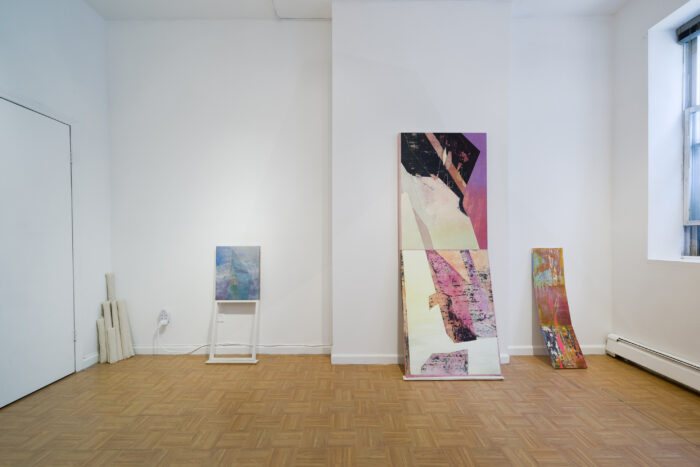
AG: Yeah, I was going to bring up the fact that you use a variety of traditional and modern materials. You have traditional rabbit skin glue, egg tempera, casein paints, oils, of course, but then also acrylics. You were at the Golden Residency last summer so you got to talk with all the technicians and figure out what cutting-edge acrylic products they have and how you can use those.
As painters we learn these rules, right? We learn the rules of “Fat over lean,” “Don’t put acrylics over oil paints,” and “Don’t mix water-based and oil-based paints”––All in order to create an archivally stable or “healthy” painting. You don’t observe those rules. This goes against the fetishization society has with preservation, especially when it comes to paintings since paintings are often seen to be investments.
The extreme of that is the Geneva Free Port, where you can buy your Rothko and then put it in a crate in a climate-controlled room and never look at it because you just want the material thing to last in pristine condition. That always makes me think about mortality and this fear of death and decay. I want to connect this fear of our mortality to the nuclear family and having kids as a way of fighting off the fear of death. And since this is like a family of paintings––what relation do these paintings or this installation have to mortality?
JD: Yeah, I didn’t really like the movie Midnight in Paris, but I always remember this line when the Ernest Hemingway character is talking to Owen Wilson, whatever his character’s name was. And Hemingway is like, “Are you afraid to die?” And Owen Wilson’s like, “Yeah, it’s probably my biggest fear.” I think that the fear of death and the fear of aging is one of the most fundamental feelings that a human being has; just being here, existing in the world. And I think that the process of holding on to objects across the generations as we grow old, and die; we pass these objects on to our kids or to foundations that take care of them, museums and stuff like… that is one of the most beautiful things that the human race does, because it’s this way of living forever, or, at least, living through the generations of a society. Because it’s really not forever-forever. But it can go on for hundreds or thousands of years. These gifts we give from one generation to another. So there’s this side of it where I think preservation is a beautiful thing, but, I do think that it can border on a complex. When you’re trying to hold on to something and have it be exactly what it is the moment it was made, and forever be like that.
Like “Oh, oh, it has to be cleaned three times a month and if there’s a crack that appears in these layers, that’s an aberration. We have to find some way of stopping that from happening.” I am fascinated with conservation and the relationships that conservators, museums, and foundations––and collectors too, I guess––form with the objects in terms of managing their age over time. But for my part, I want to create objects that feel like they’re open to evolution and change and getting wrinkles, basically, as they go through the years. I try to produce things that already from the get-go look like they’ve been beaten to shit, so if a crack forms somewhere it’s already baked into the aesthetic of what that object is. It’s not an aberration, but it’s revealing something new about the work.
AG: Yeah. Revealing something about the anatomy that is there already. Related to that is this idea of paintings as living beings that you expect to change over time, rather than be this static thing. When did you start working with that as an element of your art practice?
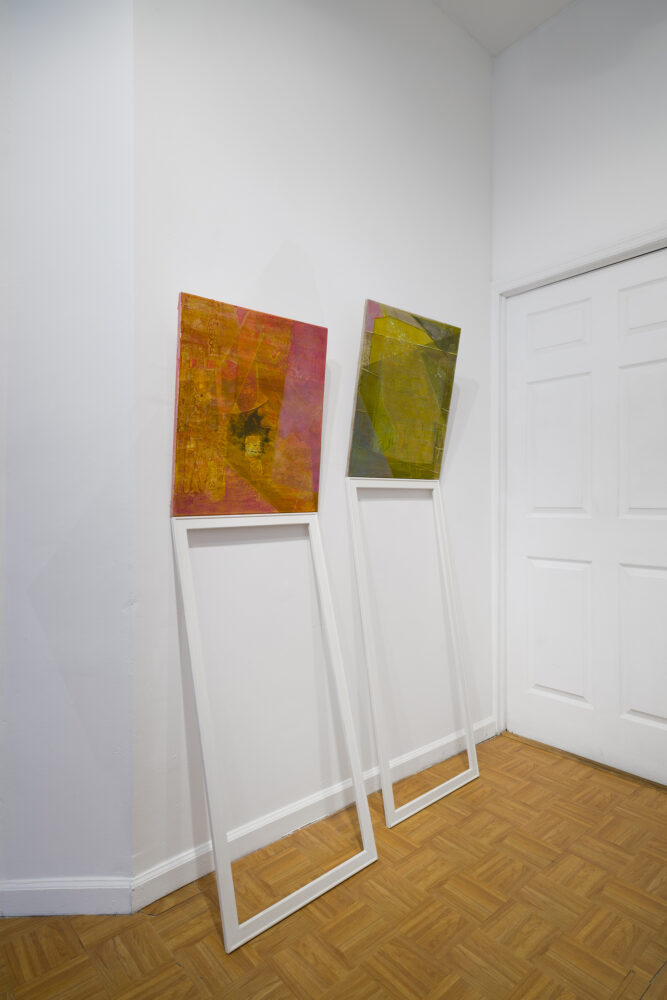
JD: Change?
AG: Yeah—letting the change and decay and cracking be anticipated in the form so that, as more of it happens, it’s part of it.
JD: Yeah. I got interested in cracks a little while back, but I fully embraced them in the mid-twenty-teens when I was in Hawaiʻi. I was living in Mānoa Valley in Honolulu in this old house, like, right on the edge of the jungle that always felt like nature was trying to take it back. When I first moved in there, there was a massive ant invasion. Just hordes of ants that were dying in piles. The paint was peeling in places. If you put anything outside it would get mildew on it. These gray spots would develop on it. Things would rust really quickly out there. It was just a very moist environment, and it was right on the edge of nature. I would get a centipede in my bed and I’m like, oh, shit! (Jan gestures as if he is throwing the centipede off his body and at the audience). It was the first time I’d ever been bitten by a centipede because my window faced the jungle.
I think that living in that house made me start to think about existing on the edge of all these other non-human processes that wanted to play on my body and my space and get in there and bring me into the fold of the jungle. I started thinking about my paintings in terms of these things trying to hold out against this world that wants to weather it and wants to incorporate it into the flow of all the other non-human stuff going on. And I think slowly I started trying to find ways in the work of interacting with that.
AG: I wonder if a distinction between artifice––something built by humans––and nature––what breaks it down––is relevant in your work as a cyclical process that happens over time. The idea of generations succeeding each other involves building and breaking down, time passing, right?––whether through biology, the passing down of genetic code, or through convention, the passing down of traditions. Embracing the natural breakdown of matter in your paintings interrupts and furthers this passing down of tradition. I don’t want to say that your paintings “subvert tradition,” because I don’t think that that’s really possible at this moment. I think the art narratives have been so fully subverted after Duchamp and Warhol that we know that anything can be art. So that’s whether you’re subverting tradition isn’t exactly the question. But after that question, when anything can be art, we’re left in this vacuum of like, “Why keep painting?” How do we as painters inherit what came before? So my question is, how do you conceive of your practice as an inheritance of different painting traditions, abstraction included?
JD: Well, what I like about the painting tradition is that it is such a convention. I think, specifically, I’m an easel painter. I’m making these things that could ostensibly go on an easel, even though I don’t work on easels. But there is this evolution. There’s this European shift from painting on the architecture of church interiors to painting onto these pieces of fabric that then could be moved around. That’s very much where I see my painting rooted in, that history.
I’m interested in the materials that were used in that history because I’m a materials freak. I’m just curious about it. I’m like, “Oh, what would happen if I put the rabbit skin glue on top of the oil and like, oh, that doesn’t work. But what if I put some egg on there” and then it sticks to the egg, For me, it’s a little bit like a child that has some stuff in front of them and just wants to fuck around with it and see what it looks like. For me, being a painter allows me to never grow up and just keep being a kid that wants to fuck around with dirt. As a child, I used to paint with water on this cement wall in my backyard. Just a bucket of water and brushes and the lines would disappear and stuff, but I just wanted to keep doing it. I like the action of doing it. And I like the convention.
I always think about the convention of the rectangle as the convention of chapters in a book; where this is a structure that you can do a lot with. You can be James Joyce. You can be Dan Brown. There’s a big range of possibilities of what you can be within the structure of a book. And I think of paintings that way, too. I could have chosen something else, but I got started painting on the wall with water. So I just kept doing it.
AG: Thinking about traditions, conventions, and families––who are your paint daddies? And do you see yourself picking up where they left off or rebelling against them?
JD: Yeah… My paint daddy. (quietly to himself) Who’s your daddy?
I really like Bill Jensen’s work. He’s a living painter that I love. He uses the philosophy of Daoism to talk about his work, which I like very much. I think of a sort of pragmatist philosophy where you have to be aware of exactly what’s happening at the moment and then adjust yourself to the ever-shifting parameters of what’s going on. And that’s the way his paintings perform. He’s always reacting to stuff that he’s already done. These paintings kick around in his studio for years. They accumulate all these layers, and things come out in the work that go unexplained to him.
I think that there’s a lot of communication that happens on an abstract material level and in color too, because color is a nonsense space. We don’t have a lot of really clear rational ways of thinking about color. And I think that’s what’s fun about it. We could say blues make us feel calm and reds make us feel, like, whatever, but I think it’s pretty irrational. I like the irrationality of material and the irrationality of color.
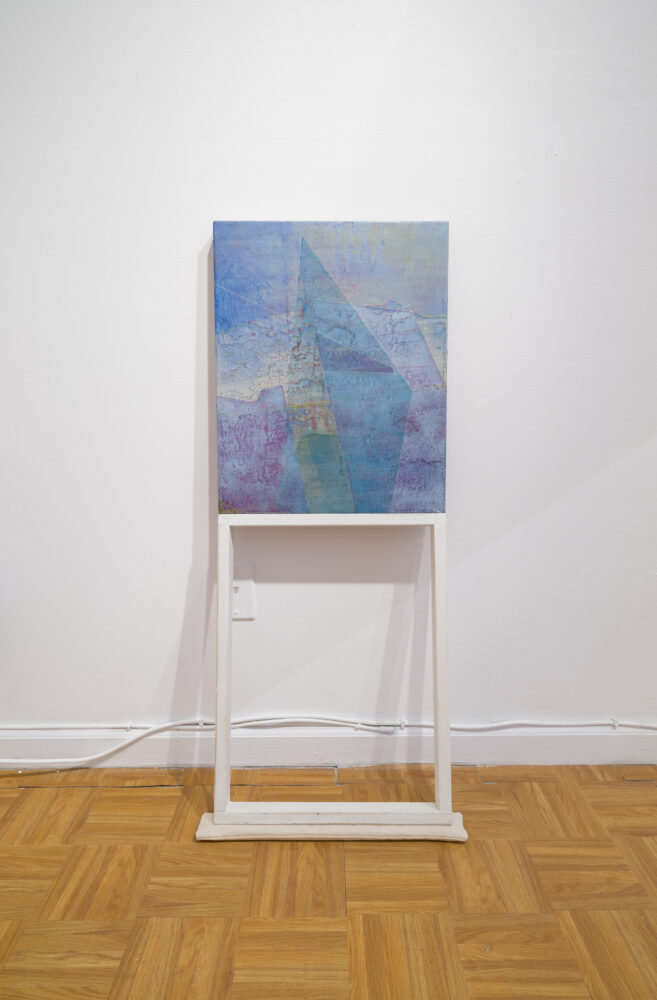
AG: Since I’ve known you, your work has pretty much become fully abstract. But when I first met you, you were painting stars as the thing that seemed to move your compositions forward. Now the light seems to have taken that up. But it’s still those angular forms that are dividing the composition and moving the eye around. What about abstraction helps you commit to painting? Why aren’t you interested in representation?
JD: Yeah, I was thinking about this this week. Like, why do I like geometric abstractions? Because that’s what these are. They’re geometric abstractions. Maybe you could say organic abstraction or some mixture of the two. I studied with this classical painter, in North Carolina around 2013, and his fundamental philosophy was that all painting—all art, really, because he had a pretty limited pre-modern idea of what art was—but he was like, all art is dividing space and ornamenting it. So I think that, on a very basic level, I do believe that to make a piece of art is to divide up a space and then do different things within those sections.
The star had been that way of dividing space for me for a little while. I wanted to move away from the star. And I started looking at light shapes falling on the work as being like, “Oh, this sections off the composition,” and it’s just a way to paint. I don’t need people to know that, even though I tell everybody who listens to me, that the paintings are made from light shapes. Because they’re not an illustration of light. The light is a means of dividing space.
AG: Yeah, like a material and temporal means of interrupting your agency, as you said.
JD: Yeah, yeah.
AG: So the last thing I want to bring up is the idea of painting as a commitment to the present moment, rather than a nostalgic, or ironic, or post-ironic—whatever the prevailing attitude of despair is these days. If your role as a painter is facilitating the bringing-into-being of this thing that has a bit of a will of its own, or a say in how it turns out—because it’s forming itself and revealing itself to you as you’re working on it—what is your commitment to that painting? How do you fulfill that commitment? That is, when is the painting finished?
JD: I was going to say, you’re just asking me: how do I know when a painting is done? (he laughs) So eloquent. Like—
AG: (laughs) Yeah, I’m trying to stay on theme.
JD: How do I know when the painting is done? It’s just a feeling, you know? It’s an irrational feeling. I mean, there is a sense where I’ve internalized composition because I’ve just been composing for a while now. What I’m looking for right now is a little bit less balance in my work. I am trying to arrive at paintings right now that throw off the sense of balance a bit, but still feel like they have an irrational or irregular balance to them. So I’m always looking for something that I haven’t seen before, specifically, I haven’t seen before in my work. It’s like a feeling when the painting gets there, and I think that there is a certain depth that I need out of the work. And just in terms of the physical layers and how many layers light has to go through because I want the work to feel like it has a physical depth to it. A painting that evades a clear or easy understanding of how it was produced. I want them to be mysterious in the way that a living thing is mysterious and be like, how the fuck did you get that way? How did your psyche evolve into who you are?
The answer is always really complicated for a person. And I want the paintings to be that too. That there’s a lot of trauma to unravel to actually understand them.
AG: A psychoanalysis for painting. (laughs)
JD: Yeah. maybe the next show, it’ll be on the couch, the daybeds, or whatever.

